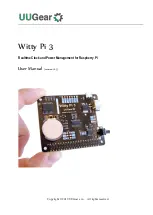
PIREG 545 cUL Operators Guide 2021
12
3. Installation and commissioning
First, check that the voltage stated on the PIREG
®
-545 resistance temperature controller matches the mains
voltage, and that the transformer primary current matches the controller's load current capability.
For safe operation, the PIREG
®
-545 resistance temperature controller may only operate in sym-
metrical TN and TT networks.
During installation, an overcurrent protection device must be provided in front of the mains input
of the PIREG
®
-545.
The PIREG
®
-545 must be connected to the mains voltage via an easily accessible and marked
isolating device (e.g., switch or circuit breaker).
3.1. Installation
The PIREG
®
-545 resistance temperature controller is only suited for use in a switch cabinet. Open operation
is not permitted.
The PIREG
®
-545 is intended to be used in a safety enclosure which should conform with requirements for
protection against the spread of fire, against electrical shock, against mechanical hazards and should have
adequate rigidity according to UL 61010-1.
The controller is designed for mounting in a control panel and the current transformer is mounted on 35mm
mounting rails as per EN 60715 (EN 50022). When mounting the controller, observe a minimum distance
of at least 20 mm to adjacent devices and cabling on all sides.
Heat dissipation from neighbouring devices must be considered (note the ambient temperature specifica-
tions).
3.2. Configuring the secondary voltage and current
The secondary voltage of the transformer may be within a range of 1...80V while the current measured
with a current transformer can range from 20 to 400 A. During AUTOCAL, the secondary voltage and
current are configured automatically. If during AUTOCAL it is found that the voltage and/or current is out-
side of the permissible range an Error signal will be displayed on the screen.
If the secondary current falls below 20A, the secondary voltage wire must be looped through the CT-50
current transformer a second time (or multiple times). Refer to the TOSS application report.
3.3. Configuring the settings
Prior to initial operation, the correct temperature coefficient must be set for the genuine TOSS Alloy 20 heat
seal band material, or the suitable heat seal band material being used. Setting too high a temperature
coefficient may lead to overheating of the heat seal band. If necessary, the variable reference temperature
must be set.
In addition, the temperature range, and the transformer type must be set. The heating ramp can be adjusted
before or after auto-calibration.
Then the PIREG
®
-545 controller can be auto-calibrated. The settings for the sequence control, monitoring,
relays etc. can be specified before or after auto-calibration.
3.4. Connecting the PIREG
®
-545
The PIREG
®
-545 must be connected according to the wiring diagrams in
Section 2.3.
or
Section 2.4.
when
using an external solid-state relay (Booster). It is not necessary to pay attention to the polarity of the current
Ir and voltage Ur measurement cables to the heat seal band, nor to the connection of the sealing trans-
former on the primary or secondary side.
When connecting a target value potentiometer, it is vital to pay attention to the correct phase sequence. In
the 0 °C setting, the resistance between terminals X20 and X23 must be 0
. See
Section 5.8.5.
The measurement cables for voltage measurement (Ur) must be connected directly to the heat seal band
and have to be twisted. (
50 turns per meter). The cables from the sealing transformer should be connected
to the heat seal band with cable lugs and not with plug-type connections. Ensure that the conductors are
of adequate cross-section. No additional components, such as fuses, switches or resistance-loaded am-
meters should be integrated in the secondary circuit of the sealing transformer.













































